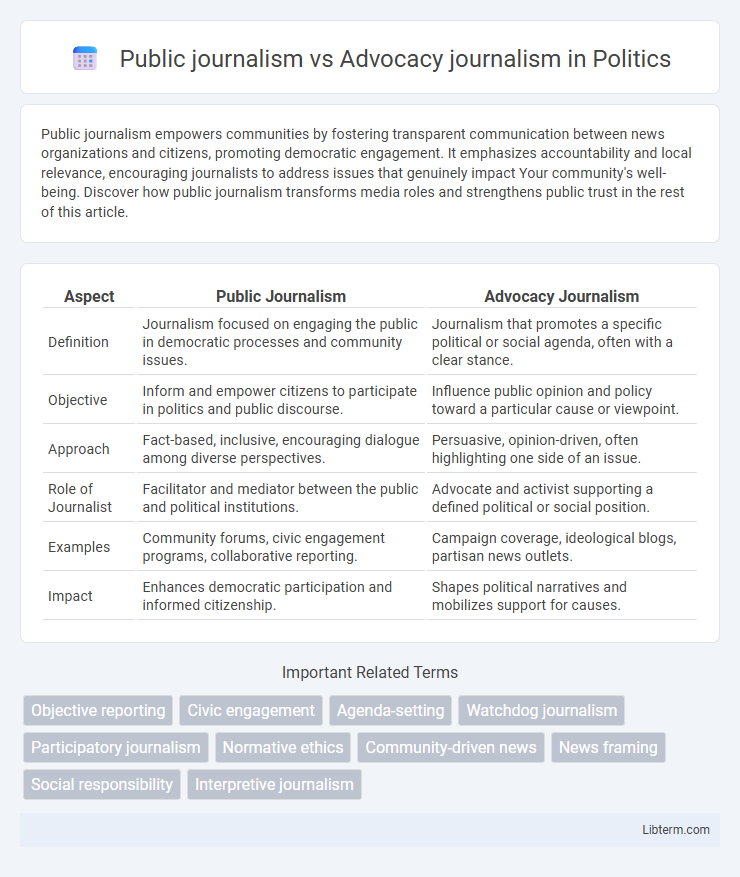Public journalism empowers communities by fostering transparent communication between news organizations and citizens, promoting democratic engagement. It emphasizes accountability and local relevance, encouraging journalists to address issues that genuinely impact Your community's well-being. Discover how public journalism transforms media roles and strengthens public trust in the rest of this article.
Table of Comparison
| Aspect | Public Journalism | Advocacy Journalism |
|---|---|---|
| Definition | Journalism focused on engaging the public in democratic processes and community issues. | Journalism that promotes a specific political or social agenda, often with a clear stance. |
| Objective | Inform and empower citizens to participate in politics and public discourse. | Influence public opinion and policy toward a particular cause or viewpoint. |
| Approach | Fact-based, inclusive, encouraging dialogue among diverse perspectives. | Persuasive, opinion-driven, often highlighting one side of an issue. |
| Role of Journalist | Facilitator and mediator between the public and political institutions. | Advocate and activist supporting a defined political or social position. |
| Examples | Community forums, civic engagement programs, collaborative reporting. | Campaign coverage, ideological blogs, partisan news outlets. |
| Impact | Enhances democratic participation and informed citizenship. | Shapes political narratives and mobilizes support for causes. |
Introduction to Public and Advocacy Journalism
Public journalism emphasizes engaging the community by fostering dialogue and addressing civic issues to enhance democratic participation. Advocacy journalism explicitly promotes specific political or social causes, aiming to influence public opinion and policy through biased reporting. Both approaches differ fundamentally in their goals, methods, and impact on media objectivity and public trust.
Defining Public Journalism
Public journalism, also known as civic journalism, focuses on engaging citizens in democratic processes by facilitating informed public discourse and promoting community problem-solving. It prioritizes transparency, inclusivity, and responsiveness to public concerns, aiming to empower individuals with relevant information rather than pushing specific opinions. In contrast, advocacy journalism explicitly supports particular viewpoints or causes, often seeking to influence public policy or social change through persuasive storytelling.
Understanding Advocacy Journalism
Advocacy journalism aims to promote specific social or political causes by actively supporting particular viewpoints and encouraging public engagement. It contrasts with public journalism, which strives to facilitate balanced community dialogue and improve democratic participation without overt bias. Understanding advocacy journalism requires recognizing its commitment to transparency and persuasive storytelling to influence public opinion and policy change.
Historical Evolution of Both Approaches
Public journalism emerged in the late 20th century as a response to growing distrust in traditional media, emphasizing community engagement and democratic discourse to enhance civic participation. Advocacy journalism has roots in the 19th century, closely linked to social movements and reform efforts, explicitly promoting particular political or social perspectives to influence public opinion. Both approaches evolved to address limitations in mainstream reporting, with public journalism prioritizing neutrality and dialogue, while advocacy journalism embraces subjective viewpoints for social change.
Core Principles and Values
Public journalism emphasizes community engagement, transparency, and fostering democratic dialogue by prioritizing the public's needs and perspectives in news reporting. Advocacy journalism centers on promoting specific social or political causes, aiming to influence public opinion and policy through persuasive and often partisan narratives. The core values of public journalism include neutrality, inclusiveness, and facilitating informed citizenship, while advocacy journalism prioritizes commitment, activism, and a clear stance on issues.
Key Differences in Reporting Styles
Public journalism emphasizes community engagement and impartiality, striving to inform citizens and foster democratic participation through balanced reporting. Advocacy journalism, by contrast, actively promotes specific viewpoints or causes, often prioritizing persuasion over neutrality in its storytelling. The key difference lies in public journalism's commitment to objectivity and civic dialogue, while advocacy journalism uses a subjective approach to influence public opinion and drive social change.
Impact on Audience Engagement
Public journalism fosters active audience engagement by encouraging community dialogue and participation in news processes, enhancing trust and social responsibility. Advocacy journalism drives strong emotional responses and mobilizes audiences around specific causes, often resulting in increased activism and awareness. Both forms influence public opinion, but public journalism prioritizes inclusivity while advocacy journalism emphasizes persuasion.
Ethical Considerations and Controversies
Public journalism emphasizes ethical responsibilities such as accuracy, transparency, and promoting informed citizenship by avoiding bias and maintaining independence from political influences. Advocacy journalism embraces a clear stance on social or political issues, prioritizing activism and perspective-driven reporting while raising concerns about potential compromise of objectivity and fairness. Ethical controversies arise around the balance between advocacy and factual integrity, with critics arguing advocacy journalism can blur lines between reporting and opinion, challenging traditional journalistic impartiality standards.
Influence on Public Discourse and Policy
Public journalism emphasizes fostering informed and engaged communities by providing balanced reporting that encourages dialogue and civic participation, thereby shaping public discourse through diverse perspectives. Advocacy journalism openly supports specific causes or viewpoints, aiming to influence policy and public opinion by presenting persuasive narratives that highlight particular issues or solutions. While public journalism promotes democratic deliberation, advocacy journalism directly seeks to drive policy changes and mobilize action around ideological goals.
Future Trends in Journalism Ethics
Future trends in journalism ethics highlight a growing emphasis on transparency and accountability in both public journalism and advocacy journalism. Public journalism increasingly integrates community engagement to foster trust, while advocacy journalism prioritizes clear disclosure of bias to maintain credibility. Emerging technologies like AI-driven fact-checking tools are set to enhance ethical standards by reducing misinformation across both journalism forms.
Public journalism Infographic

 libterm.com
libterm.com